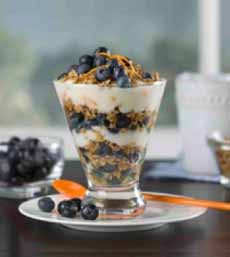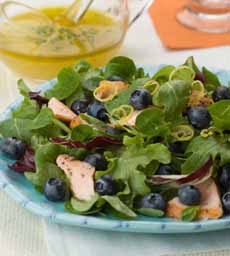Things To Do With Blueberries: Blueberry Recipes For Every Meal
|
Got blueberries? There at an excellent price right now. When October brings half-pints of blueberries for $5 and more, you’ll be sorry you didn’t enjoy more of these during peak blueberry season. So enjoy all the blueberry and mixed fruit salads, cocktails, and pies. Here are some of our recipes to include blueberries in every meal. > July is National Blueberry Month. > The year’s 35+ berry holidays. > The history of blueberries is below. BEVERAGES Blueberries (Vaccinium corymbosum) are one of the few fruit species native* to North America and unknown in Europe: perennial flowering plants with indigo-colored berries. Also included in the Vaccinium genus are cranberries, bilberries, and grouseberries. Vaccinum is a member of the Ericaceae family, which also includes the huckleberry (the most common in the U.S. is the black huckleberry, Gaylussacia baccata) and popular non-edibles including azalea, rhododendron, and various common heaths and heathers. Blueberries are called by different names, including bilberry, cowberry, farkleberry, and sparkleberry. Wild blueberries were gathered by Native Americans to eat as fresh fruit during the season and used dried fruit thereafter. |
|
|
|
The blueberry was considered a sacred food by Native Americans because the blossom-end of the berry is shaped like a five-pointed star. American Indians believed that the berries were sent by the Great Spirit during a great famine to relieve the hunger of their children [source]. The Blueberries The Pilgrims Ate Dried blueberries also sustained the Pilgrims. When they arrived at Cape Cod in November 1620, blown off course from their Virginia† destination, it was far too late to plant crops. The settlers nearly starved to death until the Wampanoag people shared food and taught them to grow native plants such as corn and squash. The settlers of Plymouth learned which foods to gather and dry (blueberries, cranberries) to sustain them through the winter. The blueberries used by the Indians were the wild or low bush variety, the state fruit of Maine, where they are a major crop. Most blueberries that are cultivated today are the high bush variety, domesticated in the early 20th century. The plants have been improved over the years to increase the berry’s size and color and the bush’s yield. Cultivation of the high-bush blueberry has been so successful that America now grows over 90% of the blueberries in the world. However, while Maine’s low-bush blueberries are significantly smaller, they are more flavorful. Some 20 years ago, blueberries were anointed a “superfood” after studies of the benefits of antioxidants became part of healthy eating in the U.S. Blueberries are one of foods highest in antioxidants. Blueberries are easily preserved by freezing, canning, and drying. They can also be juiced or made into jam or preserves. The surge in the popularity of blueberries has caused home gardeners to plant these shrubs in nearly every growing area of America. *Blueberries and cranberries, along with other indigenous fruits such as mayhaws and papwpaws, were unknown in the Old World. North America has its own native species such as cherries, grapes, plums, persimmons, raspberries, and other well-known species from the Old World. Here’s the list of fruits native to North America. †At the time, Virginia included the region as far north as the Hudson River in the modern State of New York. The Hudson River was their originally intended destination. CHECK OUT WHAT’S HAPPENING ON OUR HOME PAGE, THENIBBLE.COM. |
||







